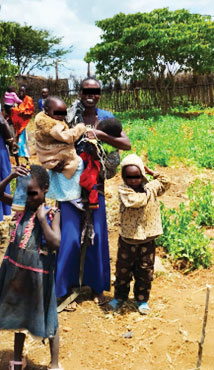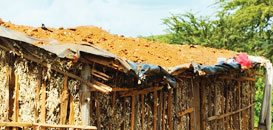Why Too Many Children: The Story of Samburu Women Simon Nyaga, Director of Bold Impact Africa (boldimpact.africa), promotes GB to small-scale farmers, as well as environmental conservation, childhood/ youth development, advocacy, community and policy development, and entrepreneurship for women and youth groups. He holds degree in Community Resource Management and Extension (BSc. CRM) from Kenyatta University, and learned GB at the GROW BIOINTENSIVE Agriculture Centre of Kenya in 2016. Samburu County lies in the northern part of the Great Rift Valley in Kenya, which is an Arid and Semi-arid region. The county, which is classified as a low potential rangeland, receives low rainfall. The county is made up of two major tribal communities: the Samburu, and the Turkana. Most community members keep livestock as their main source of livehood. However, due to low rainfall, degraded soils, and lack of food-raising skills, communities in the county have not been able to adequately exploit their potential, even as they continue to own huge parcels of land where only about 8% of land is cultivated for food growing. The remaining 92% of the land is rangeland for livestock production. I traveled to Samburu County to teach GROW BIOINTENSIVE skills to more than 50 women, youths, and children, to help them gain an alternative source of livelihood by raising their own food. It was during this journey that I came face to face with a community trapped in chronic poverty, deplorable housing, malnutrition, and disease. Social amenities such healthcare centers are miles away from where the community lives, and in addition to being trapped in abject poverty, the women also give birth to many children, year after year. On inquiry, at least from one woman I’ll call “Lesiyiai” (not her real name) said the primary reason for this high birthrate was to increase the population of the clan to protect against invasion by other tribes (the Samburu and the Turkana communities are in constant fights). There have been reported incidences of cattle rustling, highway banditry, and intra- and inter-ethnic violence, which are catalyzed by the community relying on one source of livelihood: livestock. The secondary reason for having many children is for these children to take care of the parents during their old age. A third reason is because of high child mortality rates, primarily due to diarrhea, pneumonia, and other respiratory infections, as well as other diseases.
Lesiyiai, with many others like herself, attended
my one-week GROW BIOINTENSIVE training sessions.
I noticed that she always came with four of
her children, who kept interrupting the sessions because
they all kept crying or running everywhere in
the classroom. I made a deliberate attempt to talk to
her the second day of training, and she told me she
comes to the training with four children and leaves
three more at home. In total, she has seven, and the
four she came with didn’t appear to be healthy. I
asked her if she does any kind of farming and she
told me she has never seen—or held—a digging hoe
(jembe) or even a watering can. And what broke my
heart was when I asked why she came for training,
and she told me it’s because she heard that there was
food offered (snacks) and thought she could come
and get some to feed her seven children. Each child
she bears makes it even more difficult for them to
jump out of poverty, and she is only one woman out
of many in the same situation. During the last day of training, Joshua Letereuwa, a community health volunteer, visited to see what we were doing. I was keen to ask his views, on the sidelines, about why women in his village tend to have so many children despite the high poverty rates and low-standard housing, conditions which make it almost impossible raise a healthy family. He told me that on top of the reasons given above, children herd the livestock, collect firewood, cook, and fetch water among many other household tasks. In short, to the community, these children offer cheap labor. But on top of that, he told me many women like Lesiyiai are not allowed by their husbands to take contraceptives and/or have no access to reproductive health education and services. It is to be noted that approximately 34% of the population in Samburu has the ability to read and write, and the women majority of women are illiterate. Women are regarded as the property of men and are not allowed to make any decision regarding their own lives, including how many children to give birth to. This disturbed me! On my journey back home, I kept asking myself what it would take for women like Lesiyiai to be empowered to provide for their families. How GROW BIOINTENSIVE trainings can be tailor-made to benefit women like her, and how other young women can be empowered and educated not to be enslaved and trapped into poverty because of having many children. I think reproductive health education and services are also important for all the women of reproductive age in this county. I think that programs to liberate the communities economically is of equal significance. But I also deeply think that a retrogressive culture that undervalues women should be stopped, and women must be brought to the decision- making table if change and progress is to be realized. In the end, I think GROW BIOINTENSIVE ways of growing food, coupled with nutrition education should be promoted and sustained in these communities. That requires more than a one-week GB training! If cattle theft, intra and inter-ethnic fights is to be stopped, then high-yielding, soil-growing, sustainable, small-scale food-farming methods that uses fewer resources should be encouraged. I know one day, if this is done, I will return to the community and find women allowed to give birth to children they can raise comfortably, where a community thrives in good health and nutrition, and where GROW BIOINTENSIVE contributes to food and nutrition security of every household. ♥ top | Newsletter Home |Table of Contents| Archive
|


 On inquiry, with questions
being interpreted
a local because this
woman couldn’t understand
the two national
Kenyan languages (English
and Swahili), she
told me that, like many
parents, she naturally
assumes that a high
percentage of their
children will not survive. And that giving birth to too
many children to them is, to them, like some kind of
insurance policy against the possibility of child loss
due to disease.
On inquiry, with questions
being interpreted
a local because this
woman couldn’t understand
the two national
Kenyan languages (English
and Swahili), she
told me that, like many
parents, she naturally
assumes that a high
percentage of their
children will not survive. And that giving birth to too
many children to them is, to them, like some kind of
insurance policy against the possibility of child loss
due to disease. 
